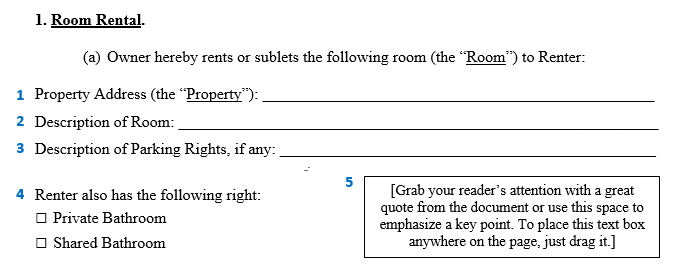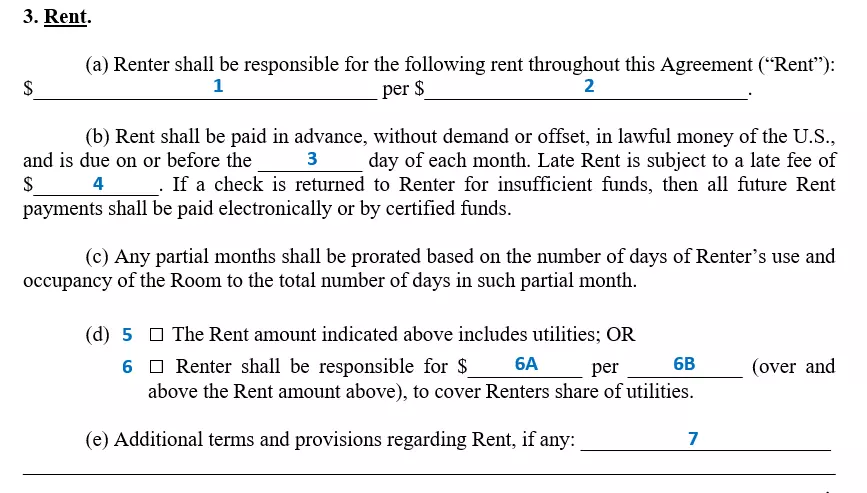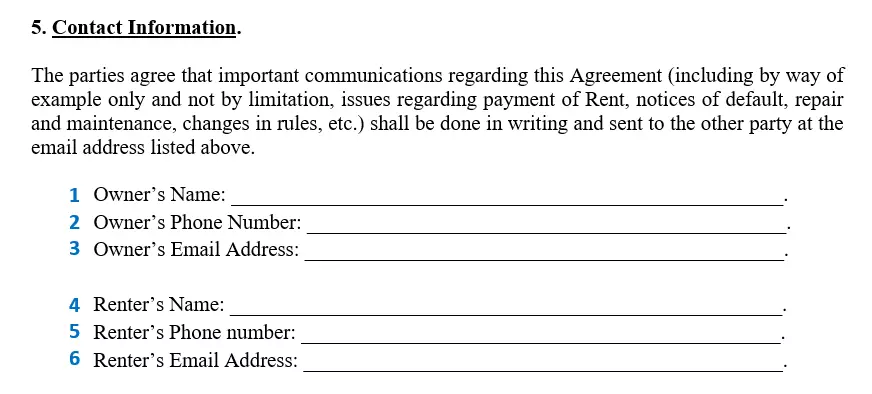Room Rental Agreement Template
Whether you’re downsizing or just looking for ways to earn more, renting out a room on your property can prove to be a good decision. Many potential tenants are now looking for space where they can live comfortably—and peaceably—with the owner or other tenants. However, more often than not, this doesn’t happen due to personal preferences and habits that get in the way of an amicable co-living.
There’s good news, though: if the landlord manages the tenant’s expectations and has everything in writing, complications like these can be avoided. The rest of this article shows you what you need to know before you get your first tenant, complete with a room rental agreement template.

Build Your Document
Answer a few simple questions to make your document in minutes
Save and Print
Save progress and finish on any device, download and print anytime
Sign and Use
Your valid, lawyer-approved document is ready
What is a Room Rental Agreement?
Imagine this—you pay a lot for a mortgage but cannot maximize your spacious property. Instead of leaving your extra rooms vacant, you invite other people to live with you. In turn, they contribute to your mortgage, making your setup a win-win situation. This is exactly what a room rental is. To give you more insight into this mutually beneficial lease arrangement, here are some definitions:
- Owner – The homeowner is considered the “landlord” who receives the rent from the tenant.
- Renter – The person residing in one of the property’s rooms. He or she is also called a “tenant.”
- Room Rental – A lease in which a tenant only rents a room in a property. He or she pays the rent directly to the owner who may or may not be living in the same property. In a room rental, the tenant normally does not have access to other rooms but can use shared areas like the kitchen, laundry area, or living room.
- Residential Lease Agreement – This type of lease is the general category of a “room rental” as it specifies all legally binding terms.
- Room Rental Agreement – This functions as a residential lease agreement but charges a significantly lower monthly rent. Though it encompasses the terms in a typical residential lease, this lease also gives great weight on house rules and security measures.
Most landlords also ask the question, “What if I don’t live on the premises?” This is also a common situation wherein the landlord stays at another address. In this case, he or she might rent out different rooms to different tenants and the process is the same, only repeated several times.
Room Rental vs. Roommate Agreement
Though the difference can be confusing, you can clearly distinguish between official room rental agreements and roommate agreements. If you’re a tenant, it’s critical to find out what you’re signing, so here are some questions to answer:
What is the payment process?
If your roommate receives the rent for you and pays it to someone else (possibly the owner), then you might be in a roommate agreement.
Is your agreement legally binding?
The only legal aspect of a roommate agreement is its financial aspect. If the agreement details how the rent is “shared” between two people, then that might possibly be a roommate agreement. However, if it’s formatted like a residential lease where there is a clear-cut landlord or owner, then you’re safe and it’s a room rental agreement.
Who is the signatory?
Check if the signatory to your lease agreement holds the deed to the home. Otherwise, your roommate might also just be another tenant.
What terms and provisions are covered?
Room lease agreements are very thorough and cover special paragraphs or government-mandated provisions (see “Filling Out the Room Rental Agreement”). If your lease agreement only details the house rules and financial aspects of the lease, then that might only be a roommate agreement.
What is it called?
A roommate agreement is also called “Joint Lease,” “Rent-a-Room Agreement,” or “Roommate Contract.” If the document you’re signing is entitled in a similar fashion, you might have to double-check.
As far as leasing goes, it’s always best to be the primary tenant or renter, so you can directly talk and negotiate with the owner. One technique you may use to confirm is to ask for the real estate documents. For landlords, make sure that the template you’re using is not a “roommate agreement” as this can be quite tricky to implement, especially from a legal standpoint. Here’s a summary for your reference:
Room Rental Agreements
- Payment goes directly to the owner
- All sections are legally-binding
- The owner signs the lease agreement
- Contains terms about legalities
- Also called “Room Lease”
Roommate Agreements
- Payment goes to the roommate
- Only the financial provision is binding
- Another tenant signs the lease agreement
- Terms are mostly room responsibilities or rules
- Also called “Joint Lease” and “Rent-a-Room Agreement”
Advantage and Disadvantages of Room Renting
A room rental is the quickest solution to mutual financial gain. Still, it’s also the fastest way to land in very complicated situations. Before you enter into this type of residential lease agreement, here are some points to consider:
ADVANTAGES FOR THE LANDLORD:
- You’ll have extra income.
- You have other people living with you in case of emergencies.
- If you’re an extrovert, you’ll love having other people around.
DISADVANTAGES FOR THE LANDLORD:
- You’ll need to balance between being a friendly “roommate” and a respected “landlord.”
- If you don’t have a good set of house responsibilities, tenants may not keep the premises clean and tidy.
- If you’re not staying on the premises, you’ll need to hire property managers or check on your place now and then.
- With the pandemic, you’ll need to be extra cautious with how you navigate around your own home. Having other people on your property can make you more prone to catching the virus.
- If you’re not staying on the leased premises, you’ll still need to monitor your tenants. Don’t worry, Section 8 of our agreement (Insurance and Non-liability) states that landlords are not responsible for COVID-19 as long as they follow protocols.
ADVANTAGES FOR THE TENANT:
- Renting out a room instead of an entire property will help you cut costs.
- You have other people living with you in case of emergencies.
- Sharing a room or a property can be a great start to lifelong friendships.
- It will help you form good habits such as regular cleaning.
- Though it will be difficult, you cannot be kicked out of the leased premises if you need to self-quarantine.
DISADVANTAGES FOR THE TENANT:
- If your landlord is also your roommate, it can get quite awkward if you miss payments.
- It’s difficult to live with other people who don’t share the same values or attention to cleanliness.
- With the pandemic, you’ll need to be extra cautious with how you navigate around your own home. Having other people in your property can make you more prone to catching the virus. The landlord won’t be responsible for the implications of COVID-19 for you and other tenants.
When you weigh the pros against the cons, it’s tempting to back out from sharing a room with others. However, this can be easily solved with a detailed room rental agreement and a good set of guidelines, which we discuss in the next sections of this article.
Steps to Finding a Good Roommate for Your Property
Step 1— Advertise your property

The manner in which you advertise your property will either attract a great crowd or a bad one. Take pictures of tidy living spaces and write clear information about your lease vacancy so that you can draw in a potential tenant who best fits your requirements. It’s also necessary to ask the questions, “What type of tenants do I want to share my property with?” and, “What type of people fit with my values?” Be careful with your words, though. Your advertisement must still follow the Fair Housing Act, which requires landlords to advertise their vacant rooms without any discrimination.
Step 2— Get to know the potential tenant

It is important for landlords to get to know their potential tenant and vice versa. You can get a lot of information from a simple document, but you do need to have a chat with the applicants if you want to draw out their personality. Ask about their likes and dislikes, hobbies, and the type of people they’re friends with. Ask details that will give you clues about how your co-living dynamics will go. Chemistry is quite important for you to live amicably with others and maintain good relations with the other party. Your tenants will be the first people you see in the morning, after all.
Step 3— Do a background check

When we say “background check,” we usually think of a credit score or criminal records. However, in a room rental agreement, you also have to check their personality and lifestyle. Once you’re done with checking their records and calling their references, chat with their old landlord and ask about how the applicant followed and upheld their lease contract. This will ensure that these new tenants will also respect your lease contract. Here’s one more trick— if they own a car, check how they maintain it. Is it messy? If they have pets, are they well-groomed and well-mannered? This will give you an idea of how they’ll use appliances or areas on your property.
Step 4— Get them acquainted with other tenants

Once your potential tenant passes your initial screening, let them meet other tenants. It’s important that other people also like the “new girl or guy.” By considering what your existing housemates think about the potential tenant, you can avoid fights and “cold wars.” In a room rental, maintaining household harmony is part of the unwritten contract of a room lease. It is therefore one of the landlord’s obligations.
What Should Be in Your House Rules?
Whether you want your household rules simple or very detailed, here are some conditions and expectations you may want to add as you draft it:
- Cleaning duties (You can also have a calendar of responsibilities for shared areas.)
- Respect for bedroom assignment (e.g., No entry regardless if the door is locked or not.)
- Appliance use (e.g., Turn off the air-conditioning when not in use.)
- Internet use (e.g., Only two devices connected at a time.)
- Kitchen use (e.g., Clean as you go.)
- Area use of other shared living spaces (These can also be posted on each area such as the laundry room.)
- Payment obligations (e.g., If the lease does not cover payments of extra utilities such as satellite TV connection or the Internet subscription, how will the tenants settle the payments?)
- Damages (Who will be responsible for repair?)
- Security Measures (e.g., Always lock the door when leaving the premises.)
- Having guests (e.g., A maximum of two guests are allowed to stay overnight, provided that the landlord is informed. No parties shall be held at the leased premises.)
- Quiet Hours (e.g., A tenant must observe 11 p.m. to 6 a.m. as quiet hours.)
- Behavioral Expectations inside the property
Room Rental Agreement Form Details
| Document Name | Room Rental Agreement Form |
| Other Names | Room Lease Agreement, Room Rental Contract |
| Avg. Time to Fill Out | 12 minutes |
| # of Fillable Fields | 68 |
| Available Formats | Adobe PDF |
| Security Deposit Laws by State | |
| Read Fair Housing Laws | |

Filling Out the Room Rental Agreement Form
Step 1— Download the room rental agreement template.
We’ve prepared a free rental agreement document that’s editable and printable. You can choose from three different formats (DOC, ODT, or PDF) and download the files on this page.
If you don’t have Microsoft Word installed on your computer, you can download the Open Office program for free.
Step 2— Write the names of both parties.
Someone who is involved in the agreement is called a “party.” In this case, the first party is composed of the “landlord” or “owner” of the property. He or she rents out a room to the second party who is identified as the “tenant” or “renter.” The tenant will then pay for the right to occupy the room for a certain duration while the landlord uses the rest of the property.

To identify those involved in the lease agreement, its opening paragraph requires the following:
- Blank 1: Full name of the landlord
- Blank 2: Full name of the tenant
- Blank 3: Date when the agreement was signed.
Step 3— Discuss the scope of the room rental agreement.
In order to avoid future complications and misunderstandings, this part of the room rental agreement document must be filled out in detail. Check the step-by-step document guide below:

In Part A of Section 1 (Room Rental), supply the following information:
- Line 1: Insert the address of the property (floor, building or house number, street, area, city, county, state, zip code).
- Line 2: Add the room’s size in square feet and its distinguishing features.
- Line 3: Add where the designated parking space is located. If this is not applicable, simply write “N/A.”
- Line 4: In most cases, a private bathroom is located inside the tenant’s room or near their space. If there is none, tick the box that says “shared bathroom.”
- Part 5: You may edit the contents of this box to emphasize a point or a notable quotation, which usually talks about any value the owner lives by (e.g. trust, responsibility, etc.).

Part B talks about shared spaces or facilities in the leased property. You may tick areas that are open for your tenant’s use. If there are any additional fees or extra charges for utilities in these areas, you may discuss the amount under Section 3 (Rent). As an alternative, you may open these spaces for your tenant and simply add your projected cost into the rental per month This can save you from complicated monthly calculations. If you prohibit access to certain areas like the basement, storage area, or indoor theater, make sure that you lock these to avoid misunderstandings. Any damages to these areas will be settled by the tenant who has obligations to repair.

Parts C and D contain standard and mandatory clauses, which are common in other rental agreements. This has also been adjusted to abide by local and national health protocols for COVID-19 and other viral illnesses. As the landlord, it is best to emphasize these to the tenant to prevent any problems should he or she be required to self-quarantine.

Part E discloses the number of allowed occupants inside the room who are also covered by the cost of the room rent. These people will also be encompassed by the terms of use in the contract. The number of people staying in a room will highly depend on the space and of the entire property. Both parties negotiate this information, so you may edit this part as follows:
- Line 1: Write the number of adults.
- Line 2: Write the number of children.
Part F or Line 9 requires you to choose whether visitors can stay overnight and use the shared areas. Therefore:
- Tick “permitted” if guests are allowed to stay overnight
- Tick “prohibited” if no guest can sleepover
- Tick the last box if the owner will decide. In this case, the tenant will usually have to put this request in writing and disclose information about the guests.
Just like the previous part, Part G requires you to choose only one option. Tick the box that applies. Should the owner or landlord tick the third box, the tenant must show pictures of his or her pets. Both parties must have this acknowledged in writing.
In Part H, the landlord must further describe the furnishings. He or she must tick the first box if there are any existing furniture inside the room and list these down on the blank provided. Otherwise, the owner may tick the second box.
Part I discusses the toiletries or kitchen utensils. In most short-term or transient rentals, bedding, towels, dishes, and other items are often provided (as in the case of AirBNB). However, longer room rental agreements usually go with the second option where the tenant will provide for his or her own.
Part J is a standard paragraph, which is further detailed in section 5.
Step 4— Agree on the term.
A room rental lease agreement document should also indicate the duration or commonly known as the “term.” This is separate from the word “terms”, which is used interchangeably with conditions, rules, or obligations in the contract.

In part A of Section 2 (Rental Term), the landlord and tenant must discuss which of the following works for both parties:
- Box 1: The rental agreement will be renewed on a monthly basis.
- Box 2: The rental will last for more than a month. If this is applicable, then the corresponding box must contain the number of months (e.g. “six months”).
- Box 3: The rental agreement does not have a fixed number of months. If this applies, then the landlord may write the specific date when the rental begins and when it ends (e.g., “November 3, 2020 to September 21, 2021”).

Parts B, C, and D discuss how the room rental agreement will expire depending on the term chosen in Part A. These are standard and there is no need to revise the above terms.

Similar to the previous parts, Parts E and F are also non-editable as these terms direct the action that the tenant must follow when the room rental agreement expires.
Step 5— Clarify the rent amount.
A room rental agreement also has similar financial aspects as residential agreements. These can be filled out as follows:

- Blank 1: Write the monthly rent amount in dollars (e.g. “$200.00”)
- Blank 2: Indicate the period. You may write “month” in the blank if you want to go what’s standard.
- Blank 3: Type the date when the tenant must pay rent. Make sure that it’s in ordinal format (e.g. “6th day of each month”)
- Blank 4: Input the numerical penalty in dollars (e.g. “5% of the monthly rental” or “$10”).
- Part 5: Select this if the utility bills are considered “inclusive” of the rent payment and there will be no additional charges.
- Part 6: If the landlord would like to charge the tenant separately for utility bills, he or she can tick box 6. Then, write the projected amount of consumption in blank 6A. The word “month” will also be added on the second blank (6B).
- Part 7: If there are any additional charges or conditions, the landlord may list these in blank 7 of the document.
Step 6— Determine the security deposit.
Having a security deposit is recommended for a new tenant, especially in a room rental agreement where they will have access to your belongings. The deposit fee may go as high as 150% of the monthly rent. This will ensure that renters won’t just disappear or discontinue the lease without notice. If they do, the security deposit will cover the cost of utilities, repair, and unpaid rent.

- Blank 1: Write the security deposit amount in numerical form.
Step 7— List the contact information.
In a room rental agreement, landlords may be renting out other rooms to other tenants or they may be staying in the same place. Either way, the agreement must detail where any written notice must be sent.

- Line 1: Landlord’s full name
- Line 2: Landlord’s mobile or phone number(s).
- Line 3: Landlord’s active e-mail address.
- Line 4: Tenant’s full name
- Line 5: Tenant’s mobile or landline number(s).
- Line 6: Tenant’s active e-mail address.
Step 8— Review how the room will be used.
Section 6 (Quiet Enjoyment) and Section 7 (Assignment and Subletting) tackle how the tenant will use the lease premises.

Specifically, for section 7, the landlord must choose if a third party can use the room (first box), if this type of use is not allowed (second box), or if the tenant must submit a notice to the owner to secure approval (third box). Since room rental agreements are complicated due to security concerns and its health implications, it is highly suggested that the owner chooses either the second or third box.
Step 9— Read the standard provisions.
Toward the end of the room rental agreement, the following standard terms must be explained to the tenant:

In Section 8 (Insurance; Non-liability of Owner), the landlord must advise the tenant to get insurance. By doing so, the landlord will not be held responsible for any losses that the tenant will incur while staying in the room or other areas of the property.
Section 9 (Default) is standard for any lease agreement. It explains that if ever the room rental agreement is breached, the responsible party must repair or address the problem. The eviction process and legal actions are also explained in this section of the agreement.

Section 11 (Additional Terms and Provisions) details the legal standards of the room rental agreement. These must be read thoroughly by both parties in order to understand the true weight of the agreement.
Step 10— Add special terms and provisions.
Section 10 (Special Terms and Provisions) is left blank for additional agreements between the landlord and tenant.

In the blank provided above, you may list separate guidelines or tenant responsibilities that were not in other sections of the room rental agreement template. These may cover room renovation or rules regarding shared areas. If the list is lengthy, the landlord may attach this as a rider document to the room rental agreement.
Step 11— Sign the room rental agreement.

The final part of the lease agreement form requires the landlord and tenant to affix their signature (lines 1 and 3). Both parties must also write their names (lines 2 and 4). After this, they must also sign on each page of the finalized room rental agreement.
A room rental agreement doesn’t have to be complicated, but it does have to be thorough. As long as you have all the necessary details for your lease agreement, the renting process becomes much easier. Notice that this guide also emphasized the value of good relationships. This is because the person renting out the room will also be the person you’ll live with for a long period of time. More than the contract, being on the same page with the tenant or landlord will give you a satisfying and comfortable life.
